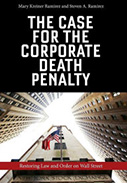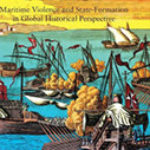THE CASE FOR THE CORPORATE DEATH PENALTY: RESTORING LAW AND ORDER ON WALL STREET

Author: Mary Kreiner Ramirez and Steven A. Ramirez
Publisher: New York, NY: New York University Press, 2017. 254p.
Reviewer: Gregg Barak | January 2017
Regarding the state of economic inequality and lawlessness in the second decade of the 21st century, Mary Ramirez and Steven Ramirez contend that the power of Wall Street and individual wealth has reached such “a level of concentration that certain financiers now operate above the criminal law insofar as financial crimes are concerned.” For well over a decade, they argue that the government has shown “no interest in toppling current management or fragmenting these firms regardless of criminality and long-standing law.” The Ramirezes conclude that the “fundamental threat to individual liberty and the rule of law arises from the concentration of economic power in the hands of the very few who exercise dominion over our financial system as well as our government.”
A fundamental question that I have been wrestling with since the 2008 financial implosion is: Were the widespread securities violations perpetrated by the megabanks and other financial behemoths of Wall Street, which caused the economic crisis and global recession to follow as well as the similarly fraudulent trader behavior that remains unimpeded by the criminal law—not prosecuted because they were and are misdirected and indefensible exceptions to the history of policing and punishing the crimes of the powerful—or/and were these illegal acts beyond incrimination because they had more fundamentally become objects of the contradictions of capital accumulation and reproduction in general and of the super-financialization of the global political economy in particular?
In The Case for the Corporate Death Penalty, Ramirez and Ramirez make an affirmative argument for why the absences of Wall Street criminal indictments represent a new era of financial impunity that has moved away from the rule of law and toward lawlessness. The Ramirezes argue that these violations could, but not in all instances, be criminally enforced without dire consequences coming to financial organizations, the global economy, or to nations at large. In short, there are typically no reasonable justifications for not criminally indicting the perpetrators of these offenses.
While I agree with the Ramirezes about the plethora of Wall Street criminality and the case that they and others are making for the use of a corporate death penalty, in both Theft of a Nation: Wall Street Looting and Federal Regulatory Colluding (2012) and Unchecked Corporate Power: Why the Crimes of Multinational Corporations are Routinized Away and What We Can Do About it (2017), I have tried to show why the punishment of the hegemonic and controlling crimes of the prevailing modes of production are rarely, if ever, criminally sanctioned relative to the quantity of the offenses. Historically, this has been the political-economic reality primarily because the appropriate criminal laws were either absent and unaccounted for, or if they did exist, these penal sanctions were at best underused.
These socio-legalistic relations are consistent with Donald Black’s theory of the “law in action” explicated in his classic work The Behavior of Law (1976, 2010). Not only does his “set of theoretical formulations predict and explain the variation in the quantity and style of law,” but they also imply that equality before the law does not exist. “The reality is legal relativism, not legal universalism.” In other words, law varies with its social geometry—its location and direction in time and space. Such “a theory completely flies in the face of the conventional conceptions of law and justice found among lawyers, judges, legal scholars, and members of the general public.”
Accordingly, rather than relying on the efficacies of an amped up criminal justice system to curb these monopolized crimes committed by Wall Street and other powerful multinationals, I have argued for alternative formations of corporate and democratic institutions, which would effectively break-up these financial cartels. Within a global and international economic arena, I think that organizational transformations would in the long run be the most effective way to diminish the dangerous concentrations of institutionalized wealth and to avoid future financial lawlessness in the securities markets.
At the same time, Ramirez and Ramirez have made me revisit and refine some of my arguments, if not, necessarily change my position on the relations of law, inequality, and unchecked corporate power.
Before turning to the contents of this outstanding book, let me testify that the Ramirezes’ examination of the absence of criminal prosecutions of securities fraud should become required reading not only for students of white-collar crime and for those practitioners engaged in corporate law enforcement, but also for the benefit of a well-informed public. There have been upwards of 150 books on the financial crisis, but none better than this one for demystifying and debunking the lack of crime control and financial justice on Wall Street.
The Case for the Corporate Death Penalty is composed of nine chapters, with those at the front and back ends a bit longer than the proofs of its arguments found in the middle five chapters. In the Introduction as well as Chapter One, A Short History of White-Collar Criminal Prosecutions, the prosecutorial context is provided and the agenda is set for exploring Wall Street’s undoing of the rule of law and what can be done about it.
For example, the very first heading in the book informs us that we are experiencing “a new criminal immunity for a new economic royalty.” We are told that by the end of 2015 the lack of criminal accountability for the Wall Street debacle accentuates that “a new and unprecedented lawlessness [has] emerged at the apex of American capitalism.” More precisely, “the most economically and politically powerful financiers [have] attained a broad criminal immunity for financial crimes.” These co-authors maintain that the crimes “committed by this new economic royalty are not deterred but [are] instead affirmed by the government’s new unspoken policy of indulgences for those most likely to shower government agents and political leaders with various forms of largesse and patronage.”
In framing the discussion for their affirmative case for “the corporate death penalty and the career death penalty in finance,” and in opposition to the “too big to fail” or “too big to jail” orthodoxy, the Ramirezes inform us that “if the size of some financial institutions creates problems with applying the rule of law to the Wall Street megabanks,” then the power of disqualification could operate “to fragment the financial services industry through spin-offs to shareholders with little or no harm to the economy. Furthermore, senior managers who tolerate criminality could face severe sanctions—even if they themselves did not commit crimes.”
Near the end of the introduction, the Ramirezes posit that the “instances of nonprosecution indicate that the DOJ will not pursue powerful players in the financial sector regardless of crisis conditions and regardless of whether the failure of the financial institutions where the criminality occurred is systemically important.”
In chapter one, Ramirez and Ramirez make their case that the “recent legal indulgences granted to financial elites for financial crimes stand without precedent in the modern American economy.” Here, the two law professors provide evidence of using the corporate death penalty as well as a succinct overview of prosecuting relatively powerful corporate offenders in the recent past. This history includes the “usual suspects” from the Savings and Loan Scandal to Enron to WorldCom to Arthur Andersen.
Chapter one also provides a modern overview of white-collar criminal liability and both legislative and case law in relation to the financial crisis as well as an overview of both the development and usage of deferred prosecution and nonprosecution agreements. These are all discussed in the context of prosecutorial discretion, abuse, and such other factors as the collateral consequences as to whether or not there is a “disproportionate harm to shareholders, pension holders, employees, and others not proven personally culpable, as well as impact on the public arising from the prosecution.” These considerations are spelled out in the guidelines for prosecutors when deciding whether or not to charge a corporation with a financial crime. This unique discretionary protocol used for corporate entities only was set forth in the revised 2008 Principles of Federal Prosecution of Business Organizations.
Chapters 2-6 usher in as much evidence as possible “in an effort to detail the most damaging misconduct at the firms that operated at the center of the crisis of 2008.” These case studies include Countrywide’s toxic subprime mortgages, Wall Street’s fraudulent sales of toxic mortgages, Lehman Brothers accounting frauds, AIG’s derivative casino, and Goldman’s Abacus scams. These stories of securities frauds and their lack of prosecutions are lucidly related for all to understand. No doubt that their clarity on the subject matter reflects the Ramirezes’ insider perspectives. They are former prosecutors and regulators who worked in the trenches during the 1980s Savings and Loan crisis to stop and jail those financial fraudsters of that era.
Before becoming law professors, Mary Ramirez had been a Prosecutor for the Department of Justice Antitrust Division. She is also a former Assistant US Attorney for the District of Kansas. Steven Ramirez had been an Enforcement Attorney for the Securities and Exchange Commission and a Senior Attorney for the Federal Deposit Insurance Corporation. Hence, their interest in this subject matter is more than academic. One might say, for them it is as personal as it is professional. Throughout the narrative and just below the surface is both their disappointment and anger with the current state of lawlessness in the world of high-stakes financial crime. Their state of being and motive forces surface in Chapter Seven, The Dimensions of Lawlessness.
After the previous five chapters have demonstrated how a series of DOJ decisions declining to prosecute high-profile cases involving the financial crisis and, after highlighting the regulatory inactivity at the FDIC, the Fed, and the SEC, the Ramirezes examine four post-crisis cases. Their objective here is to demonstrate the ways in which implied criminal immunity for powerful financial elites has spread and become the commonly practiced policy of TBTJ.
These cases include: (1) the robo-frauding, predatory mortgaging, and the 2012 announcement by the DOJ that the five largest mortgage servicers in the US had agreed to provide $25 billion in mortgage relief to distressed homeowners as well as to the states and federal government by direct payments; (2) MF Global, Jon Corzine, and the violations or failure to meet the customer segregation requirements as spelled out under the Commodity Exchange Act; (3) the pervasive megabanks’ manipulation of the benchmark interest rate known as the LIBOR (London Interbank Offered Rate); and (4) the HSBC’s intensive money laundering on behalf of drug cartels and rogue states.
In the concluding chapter, Looking Forward: Reimposing Law, the Ramirezes summarize their argument and conclusions. Most importantly, they offer a four pronged “series of solutions to the current lawlessness plaguing the financial sector and the US economy.” These include the DOJ creating a separate division dedicated to investigating and prosecuting financial crimes committed by large public firms; eliminating the use of nonprosecution agreements; expanding the corporate death penalty across criminal financial institutions; and restoring the rule of law through the pressures of electoral engagement.
With respect to Ramirez and Ramirez’s vision of a restored law and order on Wall Street, I think that at least for the immediate future that it is a “pipe dream.” After all, under the Trump Administration and the rule of the US Attorney General Jeff Sessions, deregulation, cronyism, and risk-taking are rapidly becoming the new orders of the day; foreshadowing increased, not less, lawlessness in the financial markets.
On the other hand, over the next four years there are already signs that there will be a lot more “grassroots” push back and professional litigation on behalf of the rule of law and due process. Whether one is preparing oneself or not for one of those struggles to restore law and order, The Case for the Corporate Death Penalty provides an inspired and thoughtful roadmap for knowing the new lawlessness, reviving the old rule of law, and reclaiming our democratic nation in the process.
Gregg Barak is a Professor of Criminology and Criminal Justice at Eastern Michigan University and a 2017 Fulbright Scholar to Porto Alegre, Brazil.


